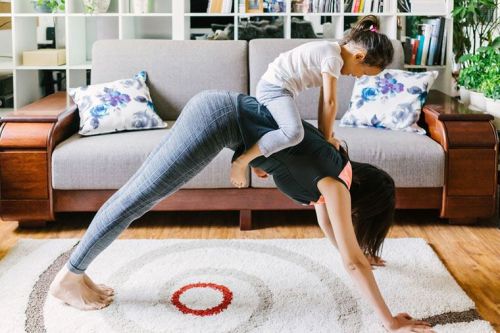When it comes to physical feats of the human body, giving birth is beyond next level. But despite the major corporeal effects of both pregnancy and labor, conversations about postpartum fitness still revolve around salvaging the body you had pre-pregnancy, rather than celebrating your new one.
“Doctors tell you that after six weeks, you’re fine to resume activity, but no one is telling us what activity to come back to,” says Joanie Johnson of New York City’s Fit Pregnancy Club. According to Johnson and her co-founder Carolina Gunnarsson, a fitness regimen that focuses on the pelvic floor is the best-kept secret for returning to your pre-baby workouts while still honoring your postpartum body.
Why? Johnson, who is a pre- and postnatal corrective exercise specialist says women should concentrate on strengthening their cores after pregnancy in order to avoid issues like leaky bladders, chronic lower back pain, and pelvic floor dysfunction.
A fitness regimen that focuses on the pelvic floor is the best-kept secret for returning to your pre-pregnancy workouts while still honoring your postpartum body.
“They come from a lack of pelvic floor activation, and it’s not something that just happens because you have a baby,” she explains. The good news: “Your pelvic floor can [be] strengthened and these issue can go away,” she says. If you’re a new mom and NYC-based—you can start strengthening yours in FPC’s brand new class, Postpartum Rehab, a baby-friendly session to help you get back in touch with your core and learn how to stabilize your new body in order to prevent injury.
If you’re not based in the city, keep scrolling for the moves FPC trainers use as the foundation for all their workouts. The goal? “Learning to breathe properly and activate the inner core unit—diaphragm, transverse abdominus, pelvic floor, multifidus muscles—is the single most-important exercise every postpartum woman should be mastering before returning to her pre-pregnancy workouts,” says Johnson.
Scroll down for the 4 postpartum, pelvic floor moves to master before hitting the gym.

Postnatal pelvic floor routine
Johnson advises trying this core and pelvic floor-centric workout before exerting any kind of force (including carrying groceries, picking up a child, or lifting weights of any kind) and continuing to incorporate it into your practice once you resume your fitness routine. Outside of the gym, she suggests you perform these four exercise while getting out of bed, standing up, getting dressed, etc. Basically: Make it your anywhere, anytime go-to.
1. Diaphragm breathing
“Inhale fully and allow the belly to soften while sending the breath low into the diaphragm,” instructs Johnson, “If you place one hand on your chest and one [on] the belly, make sure your breath is rising and falling in the belly and not the upper chest.”
2. TVA engagement (AKA: pump)
“Imagine your transverse abdominus (TVA) as a deep corset-like muscle that starts in the middle of your back, wraps around your side body and under the six pack muscles,” explains Johnson. “On your diaphragm-breath exhale, focus on wrapping the TVA around your side body and hugging your entire core in toward your midline. Every inhale should release the TVA and muscles of the core, while every exhale fully activates, wraps, or pumps the muscles closer to your body.”
3. Pelvic floor activation (AKA: kegel)
“The pelvic floor is a complex grid of muscles that runs front to back and side to side,” says Johnson. “To activate it, imagine the pubic bone, tailbone, and both sitz bones all drawing closer together and up through the center of the body. It’s important to activate the entire pelvic floor (front to back and side to side) and not just one section. And to allow the muscles to fully release and relax on your inhale—this release is just as important as the activation.” These are especially great if you experience pelvic floor weakness or tailbone pain after birth.
4. Pump-and-kegel combo
“Once you can perform the above three steps separately, practice integrating all of them together continuously,” instructs Johnson. “On your inhale, breath into the diaphragm, relax the TVA, and release the pelvic floor. On your exhale, the TVA wraps around to hug your abdominal wall closer to your midline and the pelvic floor lifts and performs a kegel.”
Once you’ve got these moves down, read up on Molly Sims’ eating plan after having a baby and how Adele dealt with her postpartum depression.
SaveSaveSaveSave
SaveSaveSaveSave
SaveSave
SaveSave
Sign Up for Our Daily Newsletter
Get all the latest in wellness, trends, food, fitness, beauty, and more delivered right to your inbox.
Got it, you've been added to our email list.











